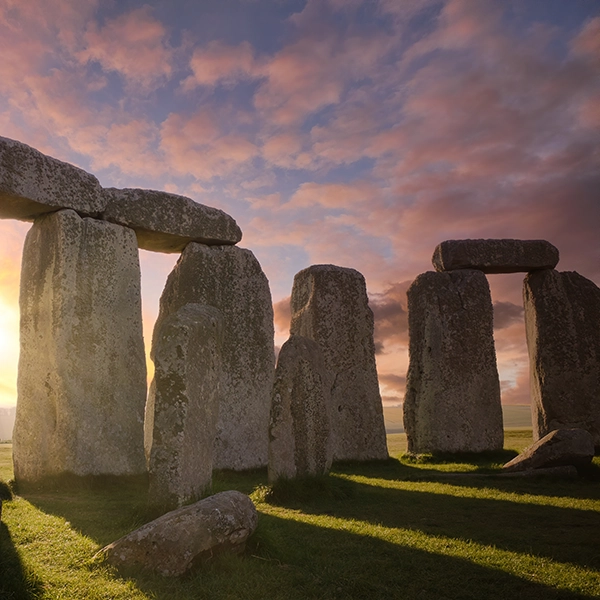Unveiling The Wonders: Fascinating Facts About Stonehenge

Stonehenge, the ancient and iconic monument located in Wiltshire, England, continues to captivate the world with its enigmatic presence. This prehistoric stone circle, dating back thousands of years, holds countless secrets and mysteries. As we delve into the intriguing history of Stonehenge, let's uncover some fascinating facts that make this monument truly extraordinary.
Age and Construction
Stonehenge is estimated to be around 5,000 years old, dating back to the late Neolithic period and the early Bronze Age. Its construction spanned several centuries, with different phases and modifications taking place over time. The monument evolved from a circular ditch and bank to the iconic stone structure we see today.
Stone Types and Origins
Stonehenge is composed of two main types of stones: the sarsen stones and the bluestones. The sarsen stones, weighing up to 25 tons each, were sourced from the Marlborough Downs, approximately 20 miles north of Stonehenge. The bluestones, smaller in size and weighing around 4 tons each, were transported all the way from the Preseli Hills in southwest Wales, about 150 miles away.
Transporting the Stones
Transporting the massive stones to Stonehenge is a remarkable feat, considering the technological limitations of the time. The transportation methods used for the sarsen stones are still a subject of speculation. However, it is believed that the bluestones were transported using a combination of boats, sledges, and rollers, making use of rivers and land routes to reach their destination.
Alignments with Celestial Events
One of the most intriguing aspects of Stonehenge is its alignment with celestial events, particularly the summer solstice. During the summer solstice, the rising sun aligns perfectly with the Heel Stone, illuminating the central altar stone. This precise alignment suggests a deep understanding of astronomy and a connection between Stonehenge and the cycles of the sun and the changing seasons.
Precise Stone Placement
The placement of stones at Stonehenge exhibits meticulous planning and precision. The lintels, which are the horizontal stones atop the vertical sarsen stones, are carefully notched and fitted together without the use of mortar. This level of craftsmanship demonstrates advanced knowledge of stone-working and engineering techniques, allowing the stones to remain stable for thousands of years.
Astronomical Sightlines
Stonehenge exhibits intentional astronomical sightlines and alignments. For example, the Avenue, a processional pathway leading to Stonehenge, is aligned with the midwinter sunset and the midsummer sunrise. This suggests that Stonehenge was designed as a place to observe and mark important celestial events, reinforcing its role as an astronomical and ceremonial site.
Changing Appearances
Over the centuries, Stonehenge has undergone various changes in appearance. The bluestones were rearranged several times during different phases of construction. Additionally, the lintels that once capped the sarsen stones have largely fallen or been removed, giving Stonehenge a more fragmented appearance compared to its original state.
A Burial Ground
Stonehenge served as a burial ground for ancient people. Excavations have uncovered cremated human remains, burial mounds, and burial pits in the vicinity of Stonehenge. This indicates that the monument held great significance in funerary practices and rituals associated with honoring the deceased.
Stonehenge as a UNESCO World Heritage Site
In 1986, Stonehenge was designated as a UNESCO World Heritage Site, recognizing its outstanding universal value and cultural significance. It joins a prestigious list of globally recognized landmarks that are deemed to be of exceptional importance to humanity.
A Site for Modern Celebrations
Stonehenge continues to attract visitors from all over the world, especially during significant celestial events like the summer solstice. During the solstice, thousands of people gather at Stonehenge to witness the sunrise and celebrate the longest day of the year. This modern-day tradition has become an integral part of Stonehenge's cultural legacy.
Ongoing Research and Conservation
Stonehenge remains a subject of ongoing research, excavation, and conservation efforts. Archaeologists, scientists, and historians continue to study the monument, its surroundings, and the cultures that existed during its construction. The aim is to gain a deeper understanding of Stonehenge's purpose, significance, and the people who built it.
Stonehenge stands as an extraordinary testament to the ingenuity and cultural heritage of our ancient ancestors. Its massive stones, precise alignments, and celestial connections continue to spark curiosity and inspire wonder. As we uncover more facts about Stonehenge, we inch closer to unraveling the mysteries and complexities of this iconic monument, further deepening our appreciation for its enduring significance.
